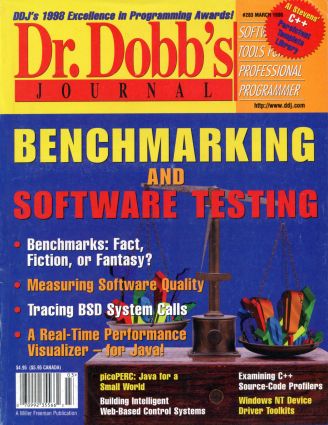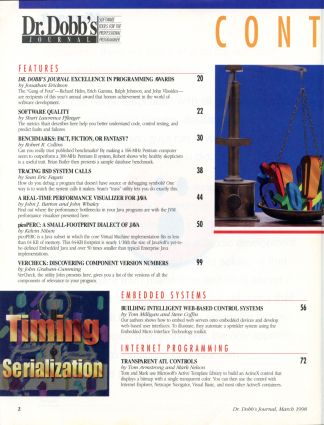
p.6 EDITORIAL
[author : Jonathan Erickson] #Edito
TABLE OF CONTENTS
FEATURES
p.20 DR. DOBB'S JOURNAL EXCELLENCE IN PROGRAMMING AWARDS
[author : Jonathan Erickson]
The "Gang of Four" — Richard Helm, Erich Gamma, Ralph Johnson, and John Vlissides — are recipients of this year's annual award that honors achievement in the world of software development.
p.22 SOFTWARE QUALITY
[author : Shari Lawrence Pfleeger]
The metrics Shari describes here help you better understand code, control testing, and predict faults and failures.
p.30 BENCHMARKS: FACT, FICTION, OR FANTASY?
[author : Robert R. Collins]
Can you really trust published benchmarks? By making a 166-MHz Pentium computer seem to outperform a 300-MHz Pentium II system, Robert shows why healthy skepticism is a useful trait. Brian Butler then presents a sample database benchmark.
p.38 TRACING BSD SYSTEM CALLS
[author : Sean Eric Fagan]
How do you debug a program that doesn't have source or debugging symbols? One way is to watch the system calls it makes. Sean's "truss" utility lets you do exactly this.
p.44 A REAL-TIME PERFORMANCE VISUALIZER FOR JAVA
[author : John J. Barton and John Whaley]
Find out where the performance bottlenecks in your Java programs are with the JVM performance visualizer presented here.
p.50 picoPERC: A SMALL-FOOTPRINT DIALECT OF JAVA
[author : Kelvin Nilsen]
picoPERC is a Java subset in which the core Virtual Machine implementation fits in less than 64 KB of memory. This 64-KB footprint is nearly 1/16th the size of JavaSoft's yet-to-be-defined Embedded Java and over 50 times smaller than typical Enterprise Java implementations.
p.99 VerCheck: Discovering Component Version Numbers
[author : John Graham-Cumming]
VerCheck, the utility John presents here, gives you a list of the versions of all the components of relevance to your program.
EMBEDDED SYSTEMS
p.56 BUILDING INTELLIGENT WEB-BASED CONTROL SYSTEMS
[author : Tom Milligan and Steve Coffin]
Our authors shows how to embed web servers onto embedded devices and develop web-based user interfaces. To illustrate, they automate a sprinkler system using the Embedded Micro Interface Technology toolkit.
INTERNET PROGRAMMING
p.72 TRANSPARENT ATL CONTROLS
[author : Tom Armstrong and Mark Nelson]
Tom and Mark use Microsoft's Active Template Library to build an ActiveX control that displays a bitmap with a single transparent color. You can then use the control with Internet Explorer, Netscape Navigator, Visual Basic, and most other ActiveX containers.
PROGRAMMER'S TOOLCHEST
p.78 SOURCE-CODE PROFILERS FOR WIN32
[author : Ron van der Wal]
Ron examines profiling tools that target Win32 C/C++ development. These tools include Intel's VTune, Microsoft's Visual C++ 5.0 profiling tools, Rational's Visual Quantify, TracePoint's HiProf, Watcom's C++ 11.0 tools, and those that come with the Win32 SDK.
p.92 WINDOWS NT DEVICE DRIVER TOOLKITS
[author : Patrick Tennberg]
Writing device drivers in C using the Windows NT Device Driver Kit can be scary. Patrick examines alternative toolkits, such as BlueWater Systems' WinDK and Vireo Software's Driver::Works.
COLUMNS
p.109 PROGRAMMING PARADIGMS
[author : Michael Swaine]
Michael doesn't do benchmarks. Well, he does, but he doesn't like to. What he really likes to do is read Dilbert — and he takes issue with those who don't.
p.117 C PROGRAMMING
[author : Al Stevens]
Al launches a new project this month — the C++ Persistent Template Library, for adding persistence to containers.
p.123 JAVA Q&A
[author : Govind Seshadri]
Java's Remote Method Invocation brings distributed-object computing to Java. Govind examines the intricacies of enabling true peer-to-peer Java RMI interaction. He then presents a step-by-step approach to implementing callbacks. Cliff Berg will return next month.
p.127 ALGORITHM ALLEY
[author : William Stallings]
Many programs need to predict the behavior of external systems. William shows how exponential smoothing fills the bill for a variety of applications.
p.133 UNDOCUMENTED CORNER
[author : Robert L. Collins]
Robert continues his discussion of the Pentium's Virtual Mode Extensions, starting with a description of the various components of VME and how they work together.
p.141 PROGRAMMER'S BOOKSHELF
[author : Jeff Cromwell]
If you need to learn more about ISAPI, the books Jeff examines here may be just the place to start. These books include Using ISAPI, by Stephen Genusa et al.; Professional Visual C++ ISAPI Programming, by Michael Tracy; and Programming ISAPI with Visual Basic 5, by Wayne S. Freeze and Tim Ritchie.
FORUM
p.8 LETTERS
[author : you]
p.18 NEWS & VIEWS
[author : the DDJ staff]
p.145 OF INTEREST
[author : Eugene Eric Kim]
p.152 SWAINE'S FLAMES
[author : Michael Swaine]

